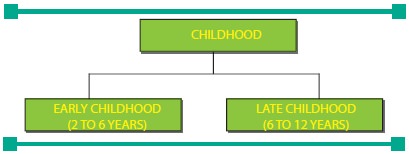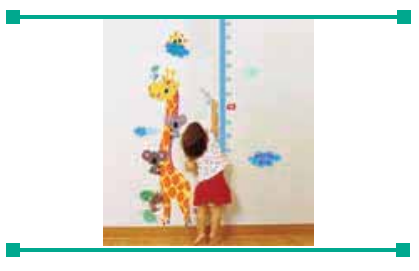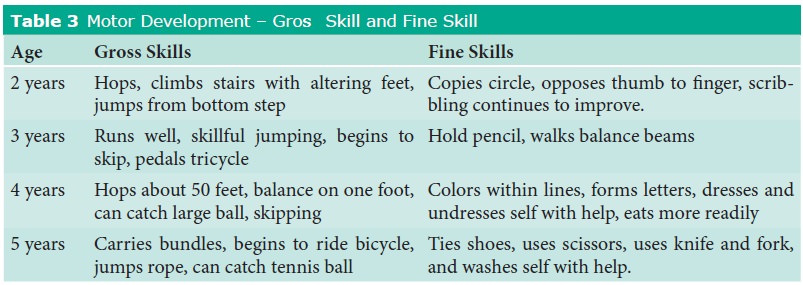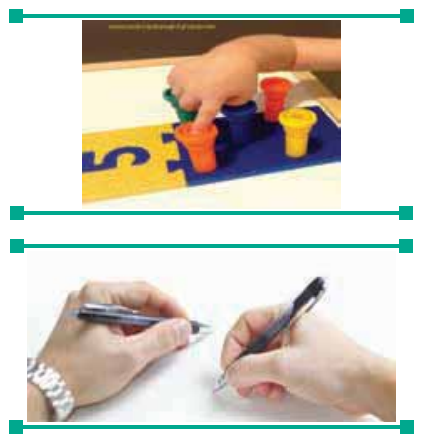Human Development and its Challenges - Childhood - Domains and Stages of Development | 11th Home Science : Chapter 2 : Human Development and its Challenges
Chapter: 11th Home Science : Chapter 2 : Human Development and its Challenges
Childhood - Domains and Stages of Development
Childhood
Childhood begins at the conclusion of babyhood
and extends to the time when the child becomes sexually mature at thir-teen
years for girls and fourteen for boys. Childhood period is now divided into –
early and late childhood.

Early Childhood
Pattern of Development in Early Childhood
Growth during early childhood proceeds at a
slow rate when compared with the rapid rate of growth in babyhood.
a. Physical Development in Early Childhood
i. Height
The average annual increase in height is 2.5
inches. By the age of six, the average child measures 46.6 inches (118.36
centimeters).

ii. Body weight
The average annual increase in weight is
around 1.6-2.3 kilograms. At age six, children should weigh approximately 7
times as much as they did at birth. An average girl weighs 25-30 kilograms and
boy weighs 30-32 kilograms.
iii. Body proportions
Body proportions change markedly and the baby look disappears. Facial features look small but chin becomes more pro-nounced and neck elongates. The stock-iness of the trunk is decreased and the abdomen appears flat. Chest and shoul-der become broader and flatter. Muscle begins to form and growth of the head slows down. Arms and legs lengthen and hands and feet grow bigger.
iv. Body build
Children have an endomorphic or mesomorphic or
ectomorphic type of body build based on their gene make up, diet and physical
activities.
v. Bones
Bone development consist of growth in bone
size, change in the number of bones and composition. The bones calcify at
different rates in differ-ent parts of the body. Bones become harder and
stronger, giving the child a firmer shape and protecting internal organs.
vi. Teeth
At the beginning of early childhood the baby
has all of their milk teeth. In the last year of early childhood the baby loses
its milk teeth which are replaced by permanent teeth. The permanent teeth to
appear first are the front cen-tral incisors. When early childhood ends the
child has one or two per-manent teeth in front and some gaps where permanent
teeth will eventually erupt.
vii. Nervous and Muscular system
The growth of the nervous system is very rapid during babyhood and slows down at 3-4 years. Development of immature to mature cells occurs at this stage. These changes are coordi-nated by the maturing brain and the nervous system promotes the devel-opment of a wide range of motor skills. The brain is about 75 percent-age of its adult weight at five years and is 90 percentage of adult weight at eight years.
viii. Sensory Organs
The growth of the eyeball is not com-plete
until puberty so young children tend to be far sighted. Vision and focusing
ability improves consider-ably as children grow through these years. The need
for corrective lenses becomes more noticeable in early childhood.
b. Motor Development
During the first four or five years, the child
gains control over gross and fine movement. Table 3 summarizes the devel-opment
of motor skill.
Artistic expression seems to peak by the end
of the early childhood period. During these years, children begin to paint and
hold the brush with thumb and fingers. They give names to their drawings and
begin to represent things.
c. Social development
This age is characterized by the widely
expanding world and awareness of people and things.
They learn how to make social con-tact and get
along with people outside the family, especially with peer group (chil-dren of
their own age). Play is an important part of social development. By the age of
3-4 years they learn to adapt and cooper-ate in group play activities. This
increases his/her social contact which increases the chances for social
behaviour of others.
i. Social Behaviours
Imitation- Children imitate the
atti-tudes and behaviour of a person whom they especially admire and want to be
like.

HANDEDNESS
Early childhood may be regarded as
a critical period in the establishment of handedness. During this period,
chil-dren shift from the use of one hand to the other and are asked to
concentrate on learning skills with one dominant hand and other as the
auxiliary or helping hand. For example in case of colouring, the dominant hand
is used for colouring and the auxiliary to hold the paper.

Rivalry- Children feel an urge
to out-do others at home and outside.
Co-operation- Children at the end of the third year learn to socialize and co-operate with their peer
group. Their inclination to play with other children increases.
Sympathy- Play contacts develop
sym-pathetic attitudes in children. This helps in understanding feelings and
emotions of others.
Sharing- Sharing and caring
will win social approval. Children learn this while playing with friends.
ii. Unsocial Behaviors
Negativism- The habit of contradict-ing
elders starts between 3 and 4 years and then it declines.
Aggressiveness- The physically
aggres-sive behaviour that begins by the age of 2, normally declines by the age
of 4 giving way to verbal attacks like name calling or blaming others.
Bossiness- Children become more authoritative at the age of 3.
Destruction- The children display their temper by destroying anything within their reach.
d. Emotional Development
The emotional expressions of children differ
from those of adults. Emotions can be broadly classified as positive emotions
(integrative) and negative emotions (dis-integrative). Such emotions are joy,
affec-tion, curiosity and sympathy. Negative emotions on the other hand give an
unpleasant feeling and disliked by others. The examples of such negative
emotions are anger, fear, jealousy, envy, grief and anxiety.
e. Cognitive Development
The mental development that occurs in early
childhood is exciting and dynamic as children explore their environment,
develop ideas, learn solutions to prob-lems, participate in imaginary play, and
gain a unique understanding of the world and how it operates. Children make
judg-ments based on a limited understanding of operations and rules and with
minimal cues and information. Young children may have trouble telling the
difference between what is real and what is fantasy. With increased ability to
ask questions in words, they understand people, objects and situation rapidly.
After this, the child obeys commands but does not under-stand why things are
right or wrong.
f. Language Development
Early childhood is known as “the chat-ter box
age” because children are able to speak with ease. They may use gestures but
mainly as supplements to speech. During early childhood, there is a strong
motiva-tion to learn to speak. At approximately 2 years of age, their ability
to use language suddenly increases rapidly. The formation of sentences follows
a fairly definite and predictable pattern in early childhood. Two to three year
old children usually use short sentences of three or four words. Many of the
sentences are incomplete.
Late Childhood
Late childhood extends from the age of six
years to the time the individual becomes sexually mature. This period is marked
by conditions that profoundly affect a child’s personal and social adjustment.
The child enters school and experiences a major change in the life pattern.
1. Physical Development
Late childhood is a period of slow and
uni-form growth until the changes of puberty begins.
Height and Weight- The child’s height and weight approximately reaches 2/3rd of adult
height. Both boys and girls can be expected to grow about two to three inches
each year. The average height for boys is slightly greater than that of girls
throughout this period. However a girl’s average height between ten and twelve
years exceeds that of boys. At the onset of puberty, an average 11 years old
girl has a height of 58 inches while an average boy of the same age has little
lesser than that.
By 6 years of age, most children are about seven
times their birth weight. Weight increase is at the rate of 1.3 to 2.3 kg. The
average 11 year old girl weighs 40.1 kg and an average boy of the same age
weighs 38.7 kg.
Body proportions- Body shapes of
indi-viduals are characterized by a greater proportion of body fat to muscle
among females, while the opposite is true for males. Facial disproportions
disappear as the mouth and jaw become larger, the forehead broadens and becomes
slimmer, the neck becomes longer, the chest broad-ens, the abdomen flattens,
the arms and legs lengthen and hands and feet grow larger but at a slow rate.
Muscle development- The increasing level and desire for physical activity in mid-dle childhood reflects
the increasing size and strength of a child’s muscle. Gain in weight is due to
increase in size of skeletal, muscular systems and some organs. Muscle mass and
strength gradually increases as “baby fat” decrease in middle and late
childhood. Throughout the middle years muscle growth tends to be extremely
rapid, and they are firmly attached to the bones. Eye-hand coordination also
improves and by twelve years of age, most children have highly coordinated
muscles.
Bone development- As the child approaches sexual maturity, the rate of bone development will
quicken in response to stimulation due to sex hor-mones that are produced in
large quan-tities. The length and width of the bones increase. In late
childhood, bones are hardened and reach a final mature shape.
Development of Teeth- The primary teeth that erupted during infancy and early child-hood are lost from
the age of six up to thir-teen years. All milk teeth are replaced with primary
teeth. Girls are found to have per-manent teeth earlier than boys.
Brain Development- About 90% of adult brain size is achieved by age six. During late childhood, brain
development includes the organization of brain func-tioning and myelination.
Functions of the right and left hemisphere become well established during this
age group.
2. Motor development during late childhood
Children are eager to participate in
activities that require large muscle movements.
They spend more time in free, unstruc-tured
activities, rough games and vigorous play such as wrestling, kicking and
chas-ing. By 6 years, most children can skip rope and begin to ride a bicycle
and by 7 years most begin to perfect the movement nec-essary for catching,
throwing, swimming and hitting ball. They develop flexibility in different
parts like wrists and legs.
3. Social development
A number of changes in social develop-ment occur
in the late childhood years. Besides the parents and the family mem-bers, the
peer group comes to take an important place in the child’s life.
Creation of childhood gangs- Upon beginning schooling, children enter the “gang age” when social
conscious-ness develops rapidly. It is character-ized by interest in peer
activities and an increasingly strong desire to be an accepted member of a
gang.
Over sensitiveness- A common out-growth of
susceptibility to social approval and disapproval is over sensitiveness. The
tendency to be eas-ily hurt by peers or siblings or parents and to interpret
what others say and do as hostile, is a measure of the children’s desire for
social acceptance.
Responsibility- Children who learn to assume responsibility at home not only make better adjustment
with their peer group but also are likely to be selected for leadership roles.
4. Emotional development in late childhood
Temper Tantrum
Tantrum or temper tantrum is an emo-tional
outburst of children. It is typically characterized by crying and screaming.

Anger
Anger is expressed when needs are not
ful-filled. It is expressed through screaming, withdrawal, destructive and
disrespectful behaviour.
Fear
Fear is still found in late childhood. A large
proportion of the fears shown in childhood persist into the adulthood.
Anxiety
Children’s anxiety increases somewhat with
maturity. This anxiety makes chil-dren bored, restless and disturbed and they
cannot concentrate. They feel inse-cure and show their anxiety by nervous
mannerism and speech problems.
5. Cognitive Development
As a child develops there are considerable
changes in his mental abilities which include imagination, memory, creativity,
question-ing and perception. They can also develop a plan to meet desired goal.
They have a better understanding of spatial concepts of causal-ity of
categorization of inductive reasoning. Children begin to read and write and
start gaining skills in reading and writing.
6. Language Development
Linguistic skills are improved or acquired by
an individual with the help of parents and from the world outside the family
such as television, radio, books and peers.

Children in the first grade, on average know
about 20,000 to 24,000 words. By the sixth grade they will know about 50,000
words. Not only do older children learn new words, they also tend to learn new
meanings for old words. The length of sentences increases from 6 years. The
characteristic chatterbox stage of early childhood is replaces by more
controlled and selective speech.
CASE STUDY
Harish
has difficulty to do home work, cannot do quiet tasks or activ-ities. He dashes
around, touching or playing with anything and everything in sight and is very
impatient. He also blurts out inappropriate com-ments, shows his emotions
without restraint, and acts without regard for consequences.
From
above case study what are your inferences about his condi-tion? What is the
specific name given to this condition?
Answer:
Harish is hyper active and his condition is called as “Attention Deficit
Hyperactivity Disorder”.
Related Topics